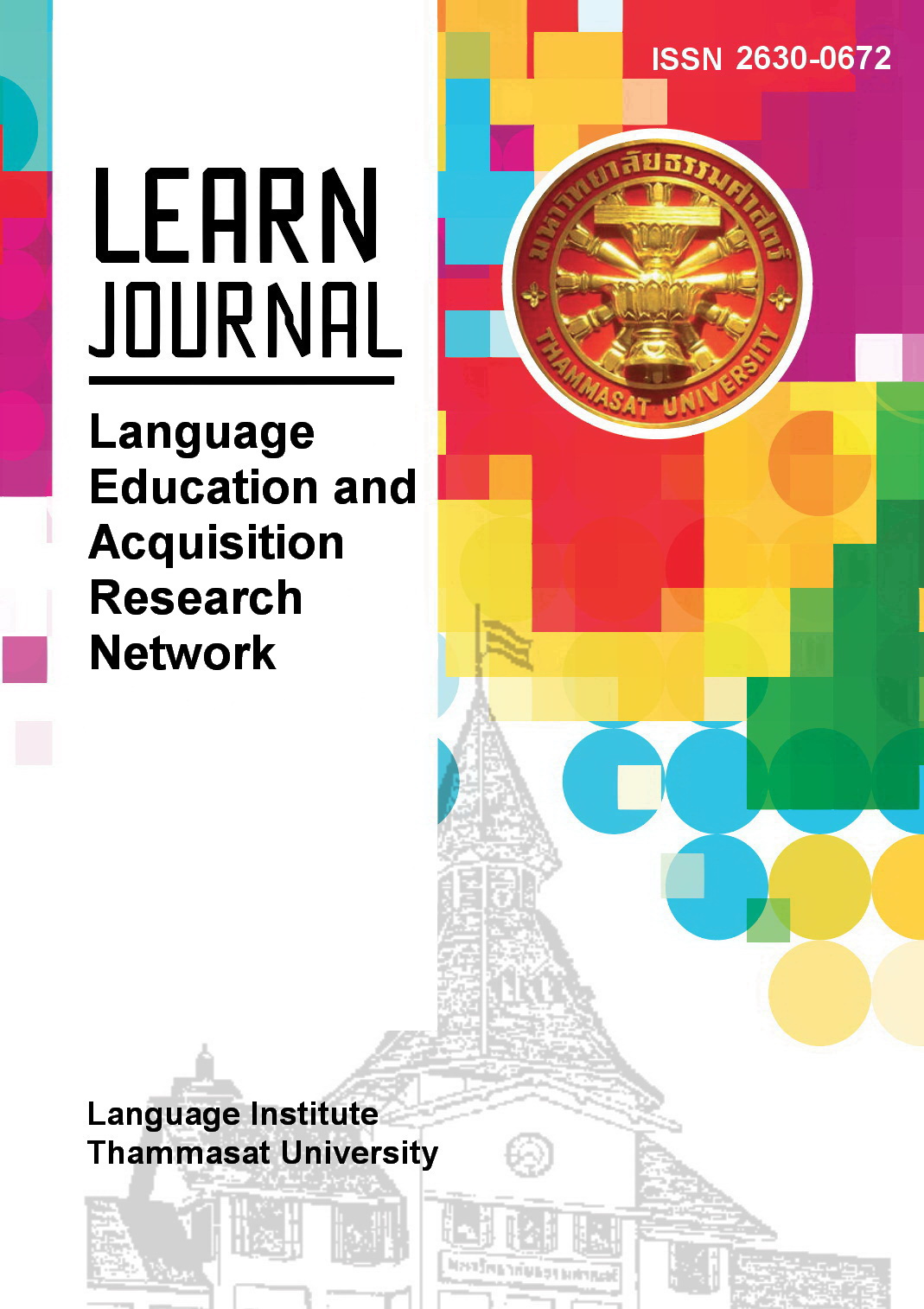Going the Extra Miles in a Reading Lesson: Insights from a Thai EFL Classroom
Main Article Content
Abstract
With the rise of the digital age and social media in the 21st century, our language learners as readers are constantly exposed to a surge of textual information daily. Inevitably, there has been a pressing need for language teachers, particularly in the EFL context, to consider higher-level comprehension and reading skills that help prepare their students for such an influx of information. This classroom-based study aimed to investigate students’ perception of 1) critical reading abilities and 2) critical literacy practice implemented in a reading lesson. The participants were 32 first-year students who studied an English foundation course at a public university in Thailand. The data were collected by means of a questionnaire and focus group interviews. Using descriptive statistics and descriptive narrative, findings revealed positive overall performance and active engagement in the lesson, while language difficulty and concerns over the abilities to read between the lines were reported. The focus group interviews reported significant engagement in the lesson. Critical reading skills and classroom discussion were found to be valuable. Critical literacy practice appeared to contribute to the participants’ positive take on learning about multiple perspectives in classroom discussion.
Article Details
References
Abednia, A., & Crookes, G. V. (2019). Critical literacy as a pedagogical goal
in English language teaching. In X. Gao (Ed.), Second handbook of
English language teaching, Springer International. (pp. 255-275)
https://link.springer.com/content/pdf/10.1007/978-3-030-02899-2.pdf
Avila, J., & Moore, M. (2012). Critical literacy, digital literacies, and
common Core State Standards: A workable union? Theory Into
Practice, 51, 27-33.
Brown, C. W. (2022). Developing multiple perspectives with EFL learners
through facilitated dialogue about images. Critical Inquiry in Language
Studies, 1-23.
https://doi.org/10.1080/15427587.2022.2030228
Brown, K. (1999). Developing critical literacy. National Centre for
English Language Teaching and Research.
Burns, A. (2009). Action research in second language teacher education.
In A. Burns, & J. Richards (Eds.), The Cambridge guide to second
language teacher education (pp. 289-297). Cambridge
University Press.
Chen, C. W. (2018). “Think before you type”: The effectiveness of
implementing an anti-cyberbullying project in an EFL classroom,
Pedagogies: An International Journal, 13(1), 1-18.
https://doi.org/10.1080/1554480X.2017.1363046
Comber, B., & Nixon, H. (2011). Critical reading comprehension in an era
of accountability. Australian Educational Researchers, 38(2), 167-179.
Goatly, A., & Hiradhar, P. (2016). Critical reading and writing in the digital age.
Routledge.
Hudson, T. (2007). Teaching second language reading. Oxford University Press.
Huh, S. (2016). Instructional model of critical literacy in an EFL context:
Balancing conventional and critical literacy. Critical Inquiry in
Language Studies, 13(3), 210–235.
https://doi. org/10.1080/15427587.2016.1154445
Janks, H. (2010). Literacy and power. Routledge.
Janks, H., Dixon, K., Ferreira, A., Granville, S., & Newfield, D. (2014).
Doing critical literacy: Texts and activities for students and teachers.
Routledge.
Kaur, S., & Sidhu, G. K. (2014). Evaluating the critical literacy practices of
tertiary students. Procedia Social and Behavioral Science, 123, 44-52.
Kemmis, S., & McTaggart, R. (Eds.). (1988). The action research planner (3rd
ed.). Deakin University Press.
Kern, R. (2000). Literacy and language teaching. Oxford University Press.
Ko, M. (2013). A case study of an EFL teacher’s critical literacy teaching in
a reading class in Taiwan. Language Teaching Research, 17(1), 91-108.
Ko. M., & Wang. T. F. (2013). EFL learners’ critical literacy practices: A
case study of four college students in Taiwan. Asia-Pacific Education
Researcher, 22(3), 221-229.
Kuo, J. (2009). Critical literacy and a picture-book-based dialogue activity
in Taiwan. Asia Pacific Education Review, 10, 483-494.
Lau, M. C. (2013). A study of critical literacy work with beginning English
language learners: An integrated approach. Critical Inquiry in
Language Studies, 10(1), 1-30.
Lew, S., Yang, A. H., Harklau, L. (2018). Qualitative Methodology. In A.
Phakiti, P. D. Costa, L. Plonsky, & S. Starfield (Eds.), The Palgrave
handbook of applied linguistics research methodology. Springer Nature Limited.
https://link.springer.com/content/pdf/bfm:978-1-137-59900-
/1.pdf
Luke, A. (2014). Critical literacy: Foundational notes. In J. Z. Pandya. & J.
Ávila. (Eds.), Moving critical literacies forward: A new look atpraxis
across contexts (pp. 19-31). Routledge.
Mackey, A., & Bryfonski, L. (2018). Mixed methodology. In A. Phakiti, P.
D. Costa, L. Plonsky, & S. Starfield (Eds.), The Palgrave handbook of
applied linguistics research methodology. Springer Nature Limited.
McLaughlin, M., & DeVoogd, G. (2004a). Critical literacy: Enhancing
students’ comprehension of text. Scholastic Inc.
McLaughlin, M., & DeVoogd, G. (2004b). Critical literacy as
comprehension: Expanding reader response. Journal of
Adolescent & Adult Literacy, 48(1), 52-62.
Ng, C., & Graham, S. (2017). Engaging readers in the twenty-first century:
What we know and need to know more. In C. Ng & B. Bartlett
(Eds.), Improving reading and reading engagement in the 21st
century (pp. 17-46). Springer Nature.
P21 Framework Definitions. (2015). Retrieved from
http://www.p21.org/storage/documents/docs/P21_Framework_
Definitions_New_Logo_2015.pdf
Pennycook, A. (2008). Critical applied linguistics and language education.
In S. May & N. H. Hornberger (Eds.), Encyclopedia of language and
education. (vol.1, pp. 169-181). Springer.
Pennycook, A. (2022). Critical applied linguistics in the 2020s. Critical
Inquiry in Language Studies, 19(1), 1-21.
https://doi.org/10.1080/15427587.2022.2030232
Shin, H., & Crookes, G. (2005). Exploring the possibilities for EFL critical
pedagogy in Korea: A two-part case study. Critical Inquiry in
Language Studies: An International Journal, 2(2), 113-136.
Wallace, C. (2003). Critical reading in language education. Palgrave Macmillan.
Williams, O. A. (2022). Critical literacy in practice: How educators leverage
supports and overcome challenges to enact critical literacy pedagogy
in their classroom. Literacy Research: Theory, Method, and Practice, 0(0),


